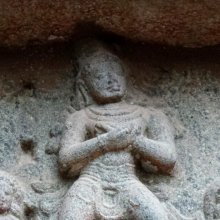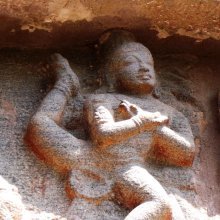Viprakirna, Viprakīrna: 10 definitions
Introduction:
Viprakirna means something in Hinduism, Sanskrit. If you want to know the exact meaning, history, etymology or English translation of this term then check out the descriptions on this page. Add your comment or reference to a book if you want to contribute to this summary article.
Images (photo gallery)
In Hinduism
Natyashastra (theatrics and dramaturgy)
Source: Wisdom Library: Nāṭya-śāstraViprakīrṇa (विप्रकीर्ण) refers to a gesture (āṅgika) made with ‘dance hands’ (nṛttahasta), according to the Nāṭyaśāstra chapter 8. The hands (hasta) form a part of the human body which represents one of the six major limbs (aṅga) used in dramatic performance. With these limbs are made the various gestures (āṅgika), which form a part of the histrionic representation (abhinaya).
Source: archive.org: The mirror of gesture (abhinaya-darpana)One of the saṃyutta-hastāni (Twenty-six combined Hands).—Viprakīrna (loosed): Svastika hands quickly separated. Patron deity Dakṣina-mūrti. Usage: drawing away the end of therobe (celāñcala), releasing.

Natyashastra (नाट्यशास्त्र, nāṭyaśāstra) refers to both the ancient Indian tradition (shastra) of performing arts, (natya—theatrics, drama, dance, music), as well as the name of a Sanskrit work dealing with these subjects. It also teaches the rules for composing Dramatic plays (nataka), construction and performance of Theater, and Poetic works (kavya).
Ayurveda (science of life)
Source: archive.org: Vagbhata’s Ashtanga Hridaya Samhita (first 5 chapters)Viprakīrṇa (विप्रकीर्ण) refers to “scattered” and is mentioned in verse 1.4 of the Aṣṭāṅgahṛdayasaṃhitā (Sūtrasthāna) by Vāgbhaṭa.—The word viprakīrṇa (and its equivalent ’thor-ba) should be interpreted to mean, not “umfangreich” as Hilgenbebg & Kirfel have it, but “scattered” as the commentators suggest; see Aruṇadatta’s paraphrase “vikṣiptebhya uccāvacoktārthatayaivetaścetaśca gatebhyo ’ta eva kaścid evārthaḥ kasmād em tantrāntarāj jñāyate”—“dispersed, gone hither and thither because of the diversity of subjects treated so that every subject is known from another work”. For ’thor-ba CD have substituted ’thob-pa, which occurs only as the future of thob-pa “to gain”; but this makes no sense in the present contest.

Āyurveda (आयुर्वेद, ayurveda) is a branch of Indian science dealing with medicine, herbalism, taxology, anatomy, surgery, alchemy and related topics. Traditional practice of Āyurveda in ancient India dates back to at least the first millenium BC. Literature is commonly written in Sanskrit using various poetic metres.
Languages of India and abroad
Sanskrit dictionary
Source: DDSA: The practical Sanskrit-English dictionaryViprakīrṇa (विप्रकीर्ण).—p. p.
1) Spread about, dispersed, scattered.
2) Loose, dishevelled (as hair).
3) Expanded, outstretched.
4) Wide, broad.
Source: Cologne Digital Sanskrit Dictionaries: Shabda-Sagara Sanskrit-English DictionaryViprakīrṇa (विप्रकीर्ण).—f.
(-rṇā) Adj. 1. Scattered, dispersed. 2. Loose, dishevelled. 3. Broad, expanded.
Source: Cologne Digital Sanskrit Dictionaries: Cappeller Sanskrit-English DictionaryViprakīrṇa (विप्रकीर्ण).—[adjective] scattered, diffused, loose (hair); expanded, wide.
Source: Cologne Digital Sanskrit Dictionaries: Monier-Williams Sanskrit-English Dictionary1) Viprakīrṇa (विप्रकीर्ण):—[=vi-pra-kīrṇa] mfn. (√kṝ-) scattered or thrown about, dispersed, dashed to pieces, [Mahābhārata; Rāmāyaṇa] etc.
2) [v.s. ...] dishevelled, loose (See [compound]), extended, wide, spacious, [Rāmāyaṇa]
Source: DDSA: Paia-sadda-mahannavo; a comprehensive Prakrit Hindi dictionary (S)Viprakīrṇa (विप्रकीर्ण) in the Sanskrit language is related to the Prakrit words: Vippaiṇṇa, Vivaiṇṇa.
[Sanskrit to German]
Sanskrit, also spelled संस्कृतम् (saṃskṛtam), is an ancient language of India commonly seen as the grandmother of the Indo-European language family (even English!). Closely allied with Prakrit and Pali, Sanskrit is more exhaustive in both grammar and terms and has the most extensive collection of literature in the world, greatly surpassing its sister-languages Greek and Latin.
Kannada-English dictionary
Source: Alar: Kannada-English corpusViprakīrṇa (ವಿಪ್ರಕೀರ್ಣ):—
1) [adjective] scattered; strewn; spread all over in a disorderly manner.
2) [adjective] wide; broad; extensive.
3) [adjective] loose; slack; not tight.
--- OR ---
Viprakīrṇa (ವಿಪ್ರಕೀರ್ಣ):—[noun] (dance.) one of the hand gestures.
Kannada is a Dravidian language (as opposed to the Indo-European language family) mainly spoken in the southwestern region of India.
See also (Relevant definitions)
Partial matches: Kirna, Vipra.
Starts with: Viprakirnaikaparshva, Viprakirnashiroruha, Viprakirnatva.
Query error!
Full-text: Viprakirnashiroruha, Viprakirnaikaparshva, Viprakirnatva, Vippainna, Vivainna, Samaskanna, Samyutta-hastani, Prakirnaka, Vyamsita, Vrishcikarecita, Nrittahasta, Svastika, Kri, Kar.
Relevant text
Search found 11 books and stories containing Viprakirna, Vipra-kirna, Vipra-kīrṇa, Viprakīrna, Viprakīrṇa; (plurals include: Viprakirnas, kirnas, kīrṇas, Viprakīrnas, Viprakīrṇas). You can also click to the full overview containing English textual excerpts. Below are direct links for the most relevant articles:
Abhinaya-darpana (English) (by Ananda Coomaraswamy)
Brihad Bhagavatamrita (commentary) (by Śrī Śrīmad Bhaktivedānta Nārāyana Gosvāmī Mahārāja)
Verse 1.2.81-83 < [Chapter 2 - Divya (the celestial plane)]
Gita-govinda of Jayadeva (comparative study) (by Manisha Misra)
10. Musical Estimate (b): The types of Prabandha songs < [Chapter 3 - A Critical and Musical study of the Gita-Govinda]
Tilakamanjari of Dhanapala (study) (by Shri N. M. Kansara)
14. Festivities on the reception of King < [Chapter 11 - Social Data]
The Matsya Purana and the Ramayana < [Purana, Volume 8, Part 1 (1966)]
Amplification of the Vedas by the Dharmasastra, Itihasa and Puranas < [Purana, Volume 4, Part 1 (1962)]
Review of Ingudi (Balanites aegyptiaca) from Kosha and Nighantus. < [Volume 2, issue 2: March - April 2015]


